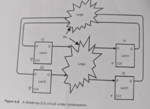venn_ng
Member level 5
Let's say I have 6 valid states for the circuit shown below. Since I have 4 latches, I could possible have 16 possible states. Is there a technique to find out if I start with one of those 10 (16-6) invalid states, can I enter the valid state or will I be stuck in those invalid states? (other than manually verifying it starting with each of those invalid states)
